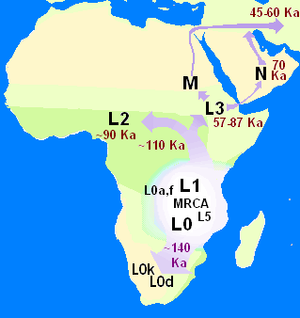L2 is considered to be the signature
Bantu haplogroup as it accounts for about half of the genetic
lineages found in Bantu populations in the southeastern portion of
Africa. Because of the geographic spread due to the Bantu migration,
L2 is the most predominant African-American mitochondrial lineage
found at 20% in the New World.
L2b might have origins in Guinea-Bissau/Senegal, Southern Africa, and some parts of Central East Africa.
My specific maternal line is
L2 is common among Niger-Kordofanian
speakers in the Senegambia region and Gold Coast region. It is also
found in descendants whose ancestors participated in the Bantu
migration. Interestingly enough, according to Bryan Sykes (2009), the
L2 haplogroup was very common amongst the African Burial Ground
population, 400 enslaved and free Africans who were buried in the
17th and 18th century in New York (Manhattan).
L2B haplogroup, dated around 30,000 years old, is generally located
over the vast area of West and Central Africa as a result of the
Bantu migration. Such haplogroup assignments can potentially shed
light on geographical aspects of slavery in Africa during the
Trans-atlantic slave trade. It is important to remember that the
western coast was not always the origin of our African ancestors but
rather the “shipping point”.
L2b might have origins in Guinea-Bissau/Senegal, Southern Africa, and some parts of Central East Africa.
My specific maternal line is
L2b1a3
.jpg) |
| As you can see, L2 is largely confined to West Africa, with some clusters also found in North Africa |
 |
| Again, a map shows that L2 is largely found in West and Central Africa. |

